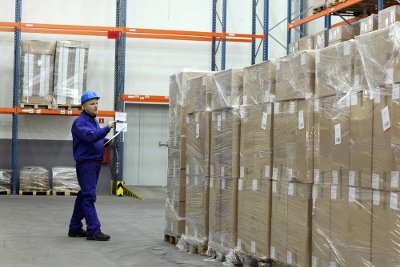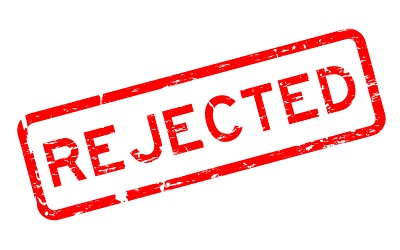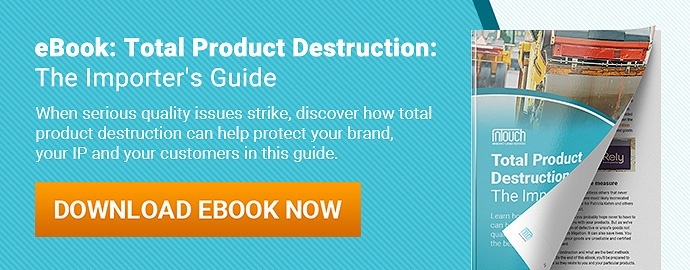 While you might not be familiar with the grey market, you’ve probably been exposed to it in one way or another when shopping. Have you ever seen genuine Gucci bags on sale at a huge discount at a Marshalls or TJ Maxx store? Or seen an authentic Omega watch listed on eBay at a much lower price than in the brand’s store?
While you might not be familiar with the grey market, you’ve probably been exposed to it in one way or another when shopping. Have you ever seen genuine Gucci bags on sale at a huge discount at a Marshalls or TJ Maxx store? Or seen an authentic Omega watch listed on eBay at a much lower price than in the brand’s store?
In these cases, the goods being sold are genuine, branded products. But how can they be sold at such low prices? Was the sale authorized by Gucci or Omega? Not exactly. These goods area being sold on what’s called the grey market, where genuine goods are sold through channels not authorized or intended by the trademark holder.
The grey market doesn’t just target luxury brands. In fact, your goods, especially your rejected products, might be on the grey market too. The grey market has ballooned with the popularity of ecommerce, which makes grey market goods available to consumers around the world.
The grey market poses a number of challenges to importers manufacturing abroad. If your supplier sells goods with your branding that don’t meet your quality standards, your brand could be irreparably damaged. Read on to learn more about how your foreign supplier could be selling your rejected products on the grey market and some preventative steps you can take to protect your brand.
What is the grey market and what does it mean for your brand?
How is the grey market different from other sales channels? A few quick definitions can help you understand the legality of grey market goods:
 Counterfeit goods are not genuine, though higher quality fakes are often indistinguishable from their genuine counterparts. A manufacturer has used trademarks (any word, name or symbol protected by intellectual property laws and used by the official manufacturer to identify their goods) without authorization from the trademark holder.
Counterfeit goods are not genuine, though higher quality fakes are often indistinguishable from their genuine counterparts. A manufacturer has used trademarks (any word, name or symbol protected by intellectual property laws and used by the official manufacturer to identify their goods) without authorization from the trademark holder.- Grey market goods are genuine, branded goods sold legally but without the consent of the trademark owner in an unauthorized market. Grey market goods are sometimes also referred to as “parallel imports”
- Black market goods are illegal goods whose production and distribution is prohibited by law. These include the sale of both counterfeit goods and genuine goods sold through illegal means.
Grey market goods are typically sold at a lower price than goods sold through authorized channels. Goods become part of the grey market when a supplier or distributor sells your genuine goods in a particular market or channel without your authorization.
The grey market feeds on scarcity or unavailability of a product through authorized channels. Some products are simply unavailable in some countries, or taxed at a high rate, making unauthorized transactions attractive.
One common example of the grey market in China is called dàigòu (代购), shoppers who travel abroad to buy goods, typically luxury items unavailable or highly taxed in China. They then resell these goods to customers in the mainland, transactions unintended by the trademark holder. A surge in Mainland Chinese traveling across the border to buy infant formula in Hong Kong sparked protests in the city and a government-mandated two-can limit in 2013.
How can the grey market hurt your brand?
The grey market can complicate your ability to control the sale of your goods and manage your brand’s reputation among potential and current customers. This can damage your brand’s competitiveness and profitability, often in multiple ways.
Increased price competition from grey market sellers
Unauthorized sellers often distribute goods at a discount, especially when exploiting differences in import tax between markets.  As a result, your brand could face increased price competition from the grey market.
As a result, your brand could face increased price competition from the grey market.
For instance, the grey market is thought to have contributed to a 10 percent decline in the export of luxury Swiss watches in 2016. Consumers have traditionally been willing to pay more for premium watches, given their reputation as high-end goods. But with the grey market, a flood of less-expensive watches on sites like WorldofWatches.com has made it difficult for luxury sellers to distribute their watches at full price.
Intellectual property leak and loss of first-mover advantage
Especially concerning for importers developing new products, competitors can sometimes obtain a product through the gray market well before it hits the intended mass market. Antsy Labs met this fate around Christmas 2016 when they chose to delay the release of their highly anticipated Fidget Cube due to quality concerns.
Before the company could resolve the issues, their product leaked on the grey market, appearing in Alibaba listings. To complicate matters, Antsy Labs still hadn’t obtained a patent for their product. And a competitor soon created a copycat product, the Stress Cube, beating the Fidget Cube to market and earning $345,000 in just two months. The deflated hype surrounding the Fidget Cube likely cost the creators millions of dollars in potential sales.
Negative customer responses to your branded products
How else do grey market goods misrepresent your brand and hurt your reputation? Grey market goods can be unsuitable for sale in unauthorized markets due to being:
 Defective or substandard—often, grey market goods might not meet your standards and specifications and might not have passed required quality control inspections and testing.
Defective or substandard—often, grey market goods might not meet your standards and specifications and might not have passed required quality control inspections and testing.- Localized or customized for a different market, like products that include an instruction manual in a certain language or a country-specific electrical power plug meant for a specific market.
- Covered under a different warranty protection, causing difficulties for your brand and customers when they expect your brand to address quality issues in grey market goods.
All of the above issues can lead to lower customer satisfaction for your brand. Customers might just complain about slightly inconvenient, but non-critical, issues, such as receiving an instruction manual written in a foreign language. But more serious issues that put consumer safety at risk could result in product liability suits and jeopardize your brand’s future success.
Identifying and addressing products with serious issues as early as possible helps limit risk of damage to your brand.
How to check if your rejected products are on the grey market
According to the “first-sale doctrine”, once a trademark owner releases their goods into commerce, they cannot prevent others from subsequently reselling those goods, including through unauthorized channels, or the grey market.
How can you know if your goods are being sold on the grey market when you have no legal protection and little control over unauthorized distribution? Let’s cover some of the steps you can take to know exactly where your products are ending up.
Maintain transparency with clear record keeping and quality control inspection
A basic starting point in accounting for all your products is to ensure you keep clear and comprehensive records of your quantities for each PO and each factory. It’s hard to know if units are missing if you don’t even know how many you should have in the first place.
Your inspection criteria, best organized in a QC checklist, should always include a quantity check and a carton weight check to help verify shipment quantities. Limitations on inspection time and cost often require checking a random sample of the total quantity, rather than counting every single unit in your PO.
But just having an outside inspector on site can signal to your supplier that you’re attentive to any shortcuts the factory might be taking and could dissuade them from selling units “out the backdoor”.
You can also confirm order quantities with container loading monitoring, where an inspector verifies the shipment as it changes hands from the factory to your logistics provider. With this additional oversight, you can verify no boxes have been opened or production units removed before shipment without your approval.
Search for your or similar products on popular ecommerce sites
Although the grey market exists offline, and has for decades, many grey market sellers have capitalized on ecommerce platforms to reach the wider international market. Prada, for example, has never sold products on either Taobao or JD.com, two popular Chinese ecommerce websites. But unauthorized sellers sold 9,000 authentic Prada products worth $3.1 million on these sites in a single month in 2016.
Keep a close eye on these sites for any products very similar to your own on sale at discounted prices. Common sites in the U.S. include eBay, Craigslist and Amazon. In China, suppliers commonly sell on local sites like Taobao, TMall and JD.com. Social media channels like WeChat and Instagram are also increasingly popular for advertising grey market and counterfeit goods.
 Each ecommerce platform has their own rules regarding counterfeit goods and unauthorized sales. As Chinese ecommerce sites seek to increase their global reach, they’ve taken steps to cater to luxury Western brands to encourage them to open accounts on their platforms. This has included removing grey market product listings and checking if vendors are using copyrighted images in listings.
Each ecommerce platform has their own rules regarding counterfeit goods and unauthorized sales. As Chinese ecommerce sites seek to increase their global reach, they’ve taken steps to cater to luxury Western brands to encourage them to open accounts on their platforms. This has included removing grey market product listings and checking if vendors are using copyrighted images in listings.
Buy your own product occasionally from sellers
You can also consider covertly buying your own product occasionally from sellers. This gives you the chance to confirm lot numbers and account for your goods in the market. If the product you receive has a falsified barcode or serial number, you have cause to question the source. And keep a look out for abnormally low prices–unauthorized sellers almost always sell goods at a discounted price.
How might your rejected products end up on the grey market?
Not all grey market goods are rejected or defective products. Sometimes your legitimate goods end up on the grey market when authorized sellers sell excess stock at the end of seasons to discount stores like TJ Maxx or Marshalls. Other times, individuals could buy up discounted goods and resell them on ecommerce sites or elsewhere.
But often, suppliers may sell your defective products to make a profit on an order they can no longer rely on payment for. These substandard goods pose the main threat to your brand’s reputation. Let’s take a look at how these rejected products might reach the grey market after you’ve indicated they aren’t suitable for sale.
Suppliers sell your unwanted inventory wholesale
Your products could end up on the grey market by your supplier selling your unwanted inventory, typically substandard goods or defective products, without your approval. This decision usually comes from higher levels of factory management. And this is especially prone to happen when you’ve rejected a large quantity of products.
How much money can a factory owner make on defective products? It’s hard to say, but any sales can help them offset costs otherwise borne when disposing of the goods. If you’ve told your supplier you’re unwilling to pay for defective products, the factory will likely look for ways to make up for their lost profits. Selling goods on the grey market can bring in profit while disposing of them properly only adds to their costs.
You might have high quality standards and don’t want to sell a product that doesn’t meet those standards. But your factory’s standards are likely quite a bit lower—it’s not their brand that’s represented on the product. It might not be readily apparent that goods are defective and the supplier might be able to con online shoppers with a flashy ad that includes your branding or copyrighted photos.
Factory staff steal and sell a small quantity of unwanted goods
There’s also a risk of lower-level factory staff stealing and selling your rejected products. Conducting a QC inspection on your full order before shipment will make it more difficult for factory staff to steal acceptable production units unnoticed.
But rejected units aren’t usually as carefully monitored and observed as goods intended for shipment. Factory staff can more easily set aside a small number of these goods for resell, though usually not in such large numbers as if the factory owner decides to sell unwanted inventory.
For example, a senior manager of the testing department of Apple’s supplier Foxconn was indicted in 2016 for stealing and reselling 5,700 iPhones that weren’t intended for sale. These goods were meant to undergo testing and then be scrapped, but instead the manager smuggled them out of the factory. Since the goods weren’t meant to go to market, no one realized what was happening until an internal audit.
Product destruction service staff steal and sell goods meant for disposal
Product destruction is usually an importer’s safest bet against protecting their brand from unauthorized sales (related: Total Product Destruction: The Importer’s Guide [eBook]). But even for brands that decide to destroy their unwanted or defective products, there’s a risk of product disposal staff stealing and reselling a small quantity of goods in the grey market.
During the destruction process, product disposal staff will have access to all of your rejected products, from pick up at the factory to transport to any outside product disposal site. Product destruction can often last several hours or even days, offering ample opportunities for product disposal staff to take a small number of goods unnoticed.
But as we’ll see next, there are a couple measures you can take to prevent this.
How product destruction helps keep your defective products off the grey market
One of the best ways to ensure substandard goods don’t hurt your business is to prevent them from ever leaving the factory in the first place. How do you do that? Destroy them. Total product destruction services, often carried out by a third-party company, offer a number of product destruction methods to effectively render your products unsellable.
 Factory owners have little motivation to destroy your rejected products of their own volition, besides their own ethics and the fear they’ll get caught. More often than not, the promise of profits from rejected products wins over a factory owner’s ethics.
Factory owners have little motivation to destroy your rejected products of their own volition, besides their own ethics and the fear they’ll get caught. More often than not, the promise of profits from rejected products wins over a factory owner’s ethics.
How to verify a product destruction service
You don’t have to rely on your supplier’s own word for assurance that your goods have been destroyed. Instead, have an impartial party, either someone on your staff or a third-party inspector, present to monitor and observe the destruction process. Hiring a trusted agent to oversee the destruction process helps ensure the rejected goods are actually destroyed. The third-party agent should pay particular attention to:
- Record the quantity of rejected products before and after destruction to ensure the process is complete.
- Certify destruction with a report that includes photos of the destruction process and disposal of destroyed goods.
Having a trusted agent overseeing destruction and submitting a detailed report of the process ensures all the goods are accounted for and destruction staff haven’t discretely taken any goods for personal use or sale.
Conclusion
The grey market remains a legal avenue for suppliers to turn your rejected products into profits, at least for the short term. If your rejected goods have already reached the market, you might be able to make a legal claim based on “material differences” and the seller’s intent to deceive customers. But there’s little established precedent on this subject in courts thus far. So you’ll likely face a long and uphill legal battle to get products off the grey market.
It’s always better to prevent an issue from arising than trying to address it after the fact. Total product destruction services offer the most assurance for importers who need to verify rejected products don’t reach the grey market.
As you craft a strategy to protect your brand in the age of ecommerce, third-party inspectors can play a valuable role in providing oversight of your supplier’s factory.
What other examples of the grey market have you discovered online or offline? Share your experiences in the comment section below!







